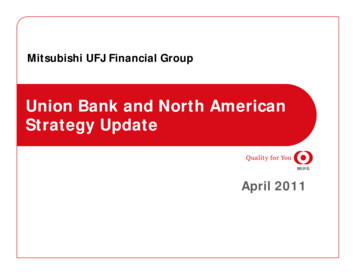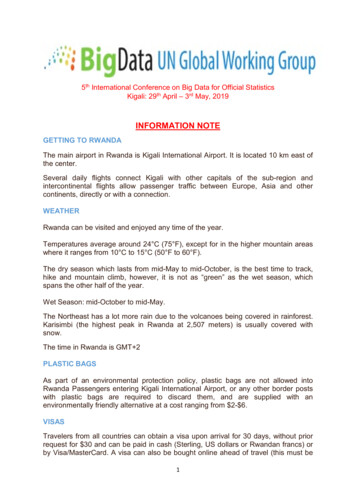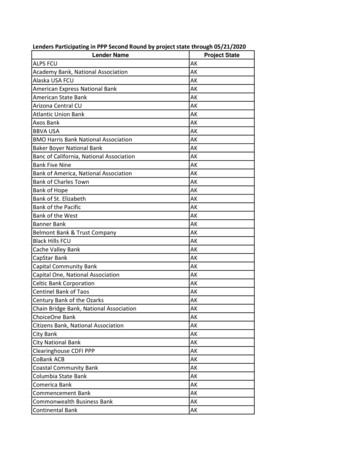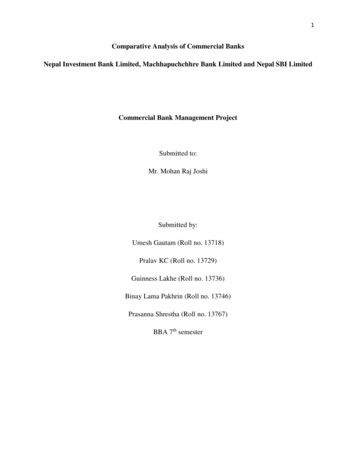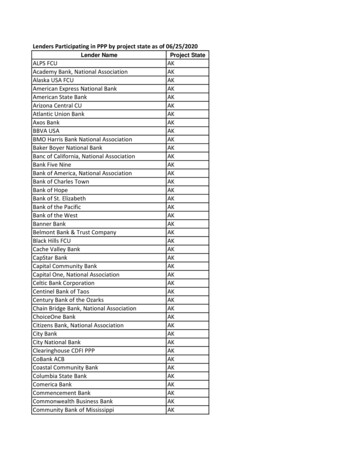
Transcription
WO R K I N G PA P E R S E R I E SN O 1 3 3 2 / A P R I L 2 011CENTRAL BANKCOMMUNICATIONON FINANCIALSTABILITYby Benjamin Born,Michael Ehrmannand Marcel Fratzscher
WO R K I N G PA P E R S E R I E SN O 1332 / A P R I L 2011CENTRAL BANK COMMUNICATIONON FINANCIAL STABILITY 1by Benjamin Born 2, Michael Ehrmann 3and Marcel Fratzscher 3NOTE: This Working Paper should not be reported as representingthe views of the European Central Bank (ECB).The views expressed are those of the authorsand do not necessarily reflect those of the ECB.In 2011 all ECBpublicationsfeature a motiftaken fromthe 100 banknote.This paper can be downloaded without charge from http://www.ecb.europa.eu or from the Social ScienceResearch Network electronic library at http://ssrn.com/abstract id 1804821.1 We would like to thank for comments Refet Gürkaynak as well as participants at seminars at Bonn University, HEI Geneva, the BIS, FU Berlin,University of St. Gallen, the ECB, and the Bank of England, the 2010 Konstanz Seminar on Monetary Theory and Policy, the 2010Finlawmetrics conference, the University of Münster/Viessmann European Research Centre/NBP conference “HeterogeneousNations and Globalized Financial Markets: New Challenges for Central Banks”, the CEPR/ESI 14th Annual Conference,and the BoK-BIS Conference on Macroprudential Regulation and Policy. We are also grateful to a large numberof colleagues in various central banks for their help in identifying the release dates of Financial Stability Reports.Earlier versions of this paper have been circulated under the title “Macroprudential policy and centralbank communication”. This paper presents the authors’ personal opinions and does not necessarilyreflect the views of the European Central Bank.2 University of Bonn, e-mail: bborn@uni-bonn.de3 European Central Bank, Kaiserstrasse 29,D-60311 Frankfurt am Main, Germany;e-mail: michael.ehrmann@ecb.europa.euand marcel.fratzscher@ecb.europa.eu
European Central Bank, 2011AddressKaiserstrasse 2960311 Frankfurt am Main, GermanyPostal addressPostfach 16 03 1960066 Frankfurt am Main, GermanyTelephone 49 69 1344 0Internethttp://www.ecb.europa.euFax 49 69 1344 6000All rights reserved.Any reproduction, publication andreprint in the form of a differentpublication, whether printed or producedelectronically, in whole or in part, ispermitted only with the explicit writtenauthorisation of the ECB or the authors.Information on all of the papers publishedin the ECB Working Paper Series can befound on the ECB’s website, tml/index.en.htmlISSN 1725-2806 (online)
CONTENTSAbstract4Non-technical summary51 Introduction62 Motivation and literature83 Measuring communication andthe effects on financial markets3.1 Choice of data frequency, data sampleand the relevant financial markets3.2 Choice and identificationof communication events3.3 Measuring the contentof communications3.4 The event study methodology4 The effects of financialstability-related communication4.1 Stylized facts about timingand content of communication4.2 Effects of FSRs and speeches/interviews4.3 Sample splits and robustness5 s25Figures and Tables27ECBWorking Paper Series No 1332April 20113
AbstractCentral banks regularly communicate about financial stability issues, by publishingFinancial Stability Reports (FSRs) and through speeches and interviews. The paperasks how such communications affect financial markets. Building a unique dataset, itprovides an empirical assessment of the reactions of stock markets to more than 1000releases of FSRs and speeches by 37 central banks over the past 14 years. Thefindings suggest that FSRs have a significant and potentially long-lasting effect onstock market returns, and also tend to reduce market volatility. Speeches andinterviews, in contrast, have little effect on market returns and do not generate avolatility reduction during tranquil times, but have had a substantial effect during the2007-10 financial crisis. The findings suggest that financial stability communicationby central banks are perceived by markets to contain relevant information, and theyunderline the importance of differentiating between communication tools, theircontent and the environment in which they are employed.JEL classification: E44, E58, G12.Keywords: central bank, financial stability, communication, event study.4ECBWorking Paper Series No 1332April 2011
Non-technical summaryThe global financial crisis has triggered heated discussions on how best to achieve financialstability in the future. An important role in that regard has been assigned to central banks,many of which have explicit financial stability mandates. In the light of this, a large numberof central banks have communicated extensively on financial stability-related matters, e.g.through the publication of Financial Stability Reports (FSRs) and financial stability-relatedspeeches and interviews.The aim of the current paper is to shed light on the potential effects of central bankcommunication about financial stability. It takes a financial market perspective and studieshow financial sector stock indices react to the release of such communication, given that thefinancial sector is one of its main addressees. For that purpose, the paper constructs a uniqueand novel database on communication comprising more than 1000 releases of FSRs andspeeches/interviews by central bank governors from 37 central banks over a time period from1996 to 2009, i.e. spanning nearly one and a half decades. The degree of optimism that isexpressed in these communications is determined using a computerized textual-analysissoftware.A first striking finding from this classification is that the tone of FSRs had continuouslybecome more optimistic after 2000, reaching a peak already in early and becoming morepessimistic thereafter. This stylized fact, together with formal tests conducted in the paper,suggests that FSRs comment on the current market environment, but also contain forwardlooking assessments of risks and vulnerabilities.The paper’s findings suggest that communication about financial stability has importantrepercussions for financial sector stock prices. Moreover, there are clear differences betweenFSRs, on the one hand, and speeches and interviews, on the other. FSRs clearly create newsin the sense that the views expressed in FSRs move stock markets in the expected direction.This effect is quite sizeable as, on average, FSR releases move equity markets by more than1% during the subsequent month. Another important finding is that FSRs also reduce noise,as market volatility tends to decline in response to FSRs. These effects are particularly strongif the FSR contains an optimistic assessment of the risks to financial stability, when FSRs arefound to move equity markets upwards in up to two thirds of the cases. Speeches andinterviews, in contrast, have only modest effects on stock market returns, and cannot reducemarket volatility.However, the effects of FSRs and speeches crucially depend on market conditions and otherfactors. Importantly, during the financial crisis, FSRs were moving financial markets less thanbefore the crisis, while speeches by governors did move financial markets. Finally, the resultsindicate that financial stability communication of central banks influences financial marketsprimarily via a coordination channel, i.e. it provides relevant information which exerts asignificant and persistent effect on markets.The findings of the paper suggest that financial stability communication by central banks areindeed perceived by markets to contain relevant information. They underline thatcommunication by monetary authorities on financial stability issues can indeed influencefinancial market developments. Yet the findings also show that such communication entailsrisks as they may unsettle markets. Hence central bank communication on financial stabilityissues needs to be employed with utmost care, stressing the difficulty of designing asuccessful communication strategy on these matters.ECBWorking Paper Series No 1332April 20115
1. IntroductionThe global financial crisis has triggered heated discussions on how best to achieve financialstability in the future. An important role in that regard has been assigned to central banks,many of which have explicit financial stability mandates. In the light of this, a large numberof central banks have communicated extensively on financial stability-related matters, e.g.through the publication of Financial Stability Reports (FSRs) and financial stability-relatedspeeches and interviews.The aim of the current paper is to shed light on the potential effects of central bankcommunication about financial stability. It takes a financial market perspective and studieshow financial sector stock indices react to the release of such communication, given that thefinancial sector is one of its main addressees. Doing so, it covers a large number of countriesover nearly one and a half decades, and studies the effects of FSRs as well as of speeches andinterviews by central bank governors.An assessment of the effects of financial stability-related communication requires a view onits aims. In line with the aims put forward by Blinder et al. (2008), we focus on the potentialof such communication to “create news” and to “reduce noise”. A number of central bankshave specified the purpose of their FSRs. The ECB’s reports, for instance, aim “to promoteawareness in the financial industry and among the public at large of issues that are relevantfor safeguarding the stability of the euro area financial system. By providing an overview ofsources of risk and vulnerability for financial stability, the Review also seeks to play a role inpreventing financial crises” (European Central Bank, 2011, p. 7).1 In light of these statements,it is interesting to study to what extent the views that a central bank expresses in itscommunications get reflected in the markets. For instance, if the central bank expresses arather pessimistic view about the prospects for financial stability, and this view gets heard infinancial markets, we would expect that stock prices for the financial sector decline. In thatsense, these communications “create news”. The other motive, to “reduce noise”, should thenbe reflected in market volatility, in the sense that a communication by the central bank shouldcontribute to reducing uncertainty in financial markets, thereby reducing volatility.But why, and through what channels should central bank communications have an effect onfinancial markets at all? A number of factors could come into play here. First, the central bankis obviously an important player in financial markets. For instance, if it is ready to change itspolicy rates, it can directly affect asset prices. Its communication can therefore exert effectsthrough what has been labelled the “signalling channel” in the literature on foreign exchangeinterventions (e.g., Kaminsky and Lewis 1996). Second, the analyses that feed into thecommunications are potentially of high quality, and there are few other institutionscommunicating about financial stability, such that a central bank publication might indeedcontain news. Thus, a co-ordination channel might be at play, whereby communication by thecentral bank works as a co-ordination device, thereby reducing heterogeneity in expectationsand information, and thus inducing asset prices to more closely reflect the underlyingfundamentals, a channel that has also been found to be important to explain the effect offoreign exchange interventions (Sarno and Taylor 2001, Fratzscher 2008). This channel mightimply that communications have longer-lasting effects, as they might change the dynamics infinancial markets.To conduct the empirical analysis, the paper constructs a unique and novel database oncommunication comprising more than 1000 releases of FSRs and speeches/interviews bycentral bank governors from 37 central banks and over the past 14 years. We not only identify1In a similar vein, the Bank of England’ FSRs aim “to identify the major downside risks to the UKfinancial system and thereby help financial firms, authorities and the wider public in managing andpreparing for these risks.” See dex.htm.6ECBWorking Paper Series No 1332April 2011
the precise timing of these communications, but we also determine their content. We employa computerized textual-analysis software (called DICTION 5.0), which allows us to gradeeach of the central bank financial stability statements, based on different semantic features,according to the degree of optimism that is expressed.A first striking finding from this classification is that the tone of FSRs had continuouslybecome more optimistic after 2000, reaching a peak already in early 2006 and becoming morepessimistic thereafter. This stylized fact, together with formal tests conducted in the paper,suggests that FSRs comment on the current market environment, but also contain forwardlooking assessments of risks and vulnerabilities.The paper’s findings suggest that communication about financial stability has importantrepercussions for financial sector stock prices. Moreover, there are clear differences betweenFSRs, on the one hand, and speeches and interviews, on the other. FSRs clearly create news inthe sense that the views expressed in FSRs move stock markets in the expected direction. Thiseffect is quite sizeable as, on average, FSR releases move equity markets by more than 1%during the subsequent month. Another important finding is that FSRs also reduce noise, asmarket volatility tends to decline in response to FSRs. These effects are particularly strong ifthe FSR contains an optimistic assessment of the risks to financial stability, when FSRs arefound to move equity markets upwards in up to two thirds of the cases. Speeches andinterviews, in contrast, have only modest effects on stock market returns, and cannot reducemarket volatility.However, the effects of FSRs and speeches crucially depend on market conditions and otherfactors. Importantly, during the financial crisis, FSRs were moving financial markets less thanbefore the crisis, while speeches by governors did move financial markets. Finally, the resultsindicate that financial stability communication of central banks influences financial marketsprimarily via a coordination channel, i.e. it provides relevant information which exerts asignificant and persistent effect on markets.The paper shows that while the release schedule of FSRs is pre-scheduled, speeches andinterviews are a much more flexible communication tool. For instance, their number is clearlypositively correlated with financial market volatility. Given their flexibility, speeches andinterviews by definition carry some surprise element. Since it is mostly at the discretion of thecentral bank governors whether or not to make statements about financial stability, the factthat a governor feels compelled to raise financial stability issues in a speech or an interviewcan therefore be an important additional news component. In contrast, due to the fixed releaseschedule for Financial Stability Reports, financial markets expect statements about financialstability issues on the release days. There might be surprising elements in their content, butthe mere fact that the FSR is released does not come as a surprise. This difference might be atthe heart of the different effects of the two instruments on market volatility.The empirical findings of the paper raise a number of policy issues. Communication onfinancial stability issues by a central bank has been and will likely be watched even moreclosely in the future, and thus can potentially have an important influence on financialmarkets. Does this imply that central banks should limit transparency and theircommunication on certain financial stability issues, as argued by Cukierman (2009), or doesthis make the case for enhanced transparency and accountability, as argued by others? Thefindings of the paper underline that communication by monetary authorities on financialstability issues can indeed influence financial market developments. Yet the findings alsoshow that such communication entails risks as they may unsettle markets. Hence central bankcommunication on financial stability issues needs to be employed with utmost care, stressingthe difficulty of designing a successful communication strategy on these matters.ECBWorking Paper Series No 1332April 20117
The paper proceeds in section 2 by outlining a more general motivation and relating thecurrent paper to the existing literature. Section 3 explains the dataset underlying the empiricalanalysis. In particular, it reports how the measures for central bank communication have beenextracted and quantified. It also shows how the incidence and the content of thecommunications relate to the external environment, and presents the event study methodologythat we employ. Section 4 discusses the empirical results and implications, and presentsrobustness tests. Section 5 concludes.2. Motivation and literatureGiven the important role of monetary authorities for financial stability, corresponding centralbank communication has always played an important role as a policy instrument, for mainlythree reasons. First, financial markets are inherently characterized by asymmetric informationand co-ordination problems, characteristics which lie at the heart of the potential risks tofinancial stability. To address these problems, transparency and communication are crucial. Inparticular, the central bank can be much more effective in promoting financial stability if ithas established a reputation that its analysis and communication are of high quality.Accordingly, communication also serves the role of making the central bank credible. Finally,any body that is entrusted with financial stability tasks will need to be accountable, whichcalls for a clear mandate, and a transparent conduct of the assigned task. Although Oosterlooand de Haan (2004) found that there is often a lack of accountability requirements for centralbanks’ financial stability objectives, this is very likely to change in the future, once financialstability has become a more important and explicit objective of central banks.These aspects of communication for financial stability do therefore closely resemble the roleof monetary policy-related communication, as established in the recent literature on centralbank communication (see, e.g., Blinder et al. 2008, Gosselin et al. 2007, Ehrmann andFratzscher 2007a). Also in the monetary policy sphere, communication serves i) to makecentral banks credible (mirroring the importance of financial stability communication forreputational purposes), ii) to enhance the effectiveness of monetary policy (just like goodfinancial stability communication can contribute to financial stability), and iii) to make centralbanks accountable.While being very similar along these three dimensions, there are also differences betweenmonetary policy-related and financial stability-related communication. Central banks havebecome much more transparent about their conduct of monetary policy over the last decades,along with an increasing importance given to communication. There is a debate on possiblelimits to central bank transparency (e.g., Mishkin 2004, Morris and Shin 2002, Svensson2006), but the arguments are much more contentious than in the case of financial stabilityrelated communication. As demonstrated by Cukierman (2009), a clear case for limitingtransparency can be made when the central bank has private information about problemswithin segments of the financial system. Release of such information may potentially beharmful, e.g. by triggering a run on the financial system. This suggests that policy makersneed to be even more careful when designing their communication strategy with regard totheir financial stability objectives.While the literature on central bank communication for monetary policy purposes has beengrowing rapidly over the recent decade, the communication on financial stability has receivedconsiderably less attention. Svensson (2003) argues that through the publication of indicatorsof financial stability in FSRs, central banks can issue early warnings to economic agents,thereby ideally preventing financial instability from materializing, and thereby ensuring thatfinancial stability concerns do not impose a constraint on monetary policy. Cihak (2006,2007) provides a systematic overview of FSRs as the main communication channel that8ECBWorking Paper Series No 1332April 2011
central banks use for this purpose. He documents, on the one hand, that the reports havebecome considerably more sophisticated over time, with substantial improvements in theunderlying analytical tools, and on the other hand, that there has been a large increase in thenumber of central banks that publish FSRs. The frontrunners are the Bank of England, theSwedish Riksbank, and Norges Bank (Norway’s central bank), all of which startedpublication in 1996/1997. It is probably not a coincidence that these three central banks aretypically also listed in the group of the most transparent central banks with regard to monetarypolicy issues (Eijffinger and Geraats 2006, Dincer and Eichengreen 2009). In the meantime,around 50 central banks are now releasing FSRs.A first empirical analysis of FSRs has been conducted by Oosterloo et al. (2007), with the aimto understand who publishes FSRs, for what motives, and with what content. Their resultsindicate that there are mainly three motives for publication, namely to increase transparency,to contribute to financial stability, and to strengthen co-operation between different authoritieswith financial stability tasks. They also find that the occurrence of a systemic banking crisis inthe past is positively related to the likelihood that an FSR is published.Even less work has been done with regard to the effects of financial stability-relatedcommunication. To our knowledge, the only exception is Allen et al. (2004), who conductedan external evaluation of the Riksbank’s work on financial stability issues, and came up witha number of recommendations, such as making the objective of the Riksbank’s FSRs explicit,providing the underlying data, or expanding the scope of the FSR to, e.g., the insurancesector. The present paper aims to fill this gap and analyzes how central bank communicationsabout financial stability are received in financial markets.3. Measuring communication and the effects on financial marketsThis section introduces the dataset that we develop to study the effects of financial stabilityrelated communication. We start by explaining the choice of data frequency, the sample ofcountries and time that we use, and the choice of the financial sector stock market indices asour measure for financial markets. Subsequently, we describe the process for identifying therelevant communications, how their content is coded, and the econometric methodology.3.1 Choice of data frequency, data sample and the relevant financial marketsWe are interested in the effects of financial stability-related communication on financialmarkets. A first choice that is required relates to the frequency of the analysis. Given thespeed of reactions in financial markets, it is necessary to identify the timing of the events asprecisely as possible. Identification of a precise time stamp will allow for an analysis in a verytight time window around the event, thereby ensuring that the market reaction is not distortedby other news. We opted for a daily frequency for two practical reasons. First, given the aimto provide a cross-country study over a relatively long horizon, financial market data are notconsistently available at higher frequencies. Second, the identification of the precise days ofthe release of central bank communications has already not been trivial in many cases,whereas the identification of the exact time of the release within a day is largely impossible.While a higher frequency might have been desirable, it is important to note that the dailyfrequency is commonly employed in the announcements effect literature – for instance, twoclassic references with regard to the effect of monetary policy on stock markets, Rigobon andSack (2004) as well as Bernanke and Kuttner (2005) both use daily data.The sample of countries and the time period of the study have been determined on the basis ofthe release of FSRs. We tried to identify the release dates of the FSRs or relevant speeches orinterviews by central bank governors for all those central banks listed in Cihak (2006, 2007),i.e. for all central banks which release FSRs. We succeeded to identify such release dates forECBWorking Paper Series No 1332April 20119
35 countries, 24 of which are advanced economies according to the IMF’s countryclassification. Additionally, we included the euro area, as well as the United States as the onlycountry that does not release an FSR, restricting ourselves to studying the effect of speechesand interviews in this case. In total, our sample therefore covers 37 central banks (see Table1). Our sample starts in 1996, i.e. the year when the first FSR was released by the Bank ofEngland. The data were extracted in October 2009, such that the sample ends on September30, 2009.As to the selection of a financial market that shall be subject of this study, we opted for stockmarket indices relating to the financial sector, as we expect that empirical effects of financialstability communication should be most easily detectable for this sector. Such data areavailable from Datastream back to 1996, i.e. to the start of our sample period, for all thecountries in our sample. This choice is partially owed to the large cross-country dimensionand the need to get historical data for nearly one and a half decades, which limited theavailability of less traditional market measures, such as implied volatilities or expecteddefault frequencies (EDFs). While the link of these measures to financial stability would havebeen relatively direct, we hope that the financial sector stock indices (using MSCI indices)provide a measure that is reasonably closely related to financial stability issues, too. All stockindices are expressed in local currency, given that we are interested in the response of nationalfinancial markets to national communication. We will furthermore show that our results arerobust to using the overall stock market indices, rather than focusing on the financial sectorstocks alone.3.2 Choice and identification of communication eventsAt the core of this paper is a measure of communication events that quantifies the content ofcommunication. We focus on the two most important channels of communication aboutfinancial stability issues, namely FSRs and speeches and interviews. FSRs are typicallyrelatively comprehensive documents that discuss various aspects of financial stability. Theynormally begin with an overall assessment of financial stability in the respective country,often including an international perspective. They usually contain an evaluation of currentmacroeconomic and financial market developments and the assessment of risks to banks andsystemically relevant non-banking financial institutions. Cihak (2006) calls these sections the“core” part of an FSR and differentiates them from the “non-core” part that includes researcharticles on special issues, often written by outside experts. The weights attributed to these twoparts vary considerably across central banks. The spectrum ranges from FSRs that only coverthe core part (e.g. Norway) to FSRs which only consist of articles covering a special topic(e.g. France). Most central banks lie somewhere in between this range and are usually closerto the first type. Typically, FSRs are published twice a year, i.e. are relatively infrequentcommunications.A second important channel for central banks to communicate about financial stability issuesis to give speeches and interviews. By their very nature, these are much more flexible thanFSRs. Their timing can be chosen flexibly (Ehrmann and Fratzscher (2007b, 2009) haveshown this for monetary policy-related speeches), and their content can be much morefocused. Of course, this is also due to the fact that they are much shorter than FSRs.As we are interested in testing the response of financial markets to central bankcommunication, we need to identify the release dates as a first step (recall that we willconduct the analysis at a daily frequency, hence there is no need to identify the timing withina given day – as long as the release takes place before markets close). As to FSRs, wecarefully ensured a proper identification of their release dates, mainly based on informationprovided on central banks’ websites and by central bank press offices, and complementedwith information from news reports about the release of FSRs as recorded in Factiva, adatabase that contains newspaper articles and newswire reports from 14,000 sources. Asshown in Table 1, the dataset contains information on 367 FSRs. The increasing tendency of10ECBWorking Paper Series No 1332April 2011
central banks to publish FSRs is reflected in this database. Starting from less than 10 FSRsper annum in the 1990s, we could identify around 50 FSRs each year in the mid 2000s (notethat the drop in numbers in 2009 is entirely due to the fact that the sample ends in September,i.e. covers only three quarters of the year). As to the country coverage, the early publishers areobviously represented more frequently, with 20 and more reports, whereas “late movers” havefar fewer observations, down to 1 for the case of the Bank of Greece, which published its firstFSR in June 2009 (for Indonesia and the Philippines, we could not identify the release dat
Financial Stability Reports (FSRs) and through speeches and interviews. The paper asks how such communications affect financial markets. Building a unique dataset, it provides an empirical assessment of the reactions of stock markets to more than 1000 releases of FSRs and speeches by 37 central banks over the past 14 years. The




